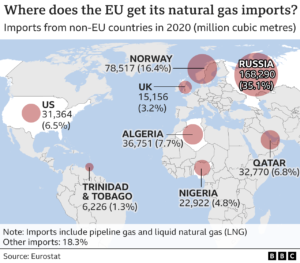Brussels, (Parliament Politics Magazine) – To lessen Europe’s dependency on Russian fuel, the US and EU have signed a vast gas deal on Liquefied Natural Gas. Through the year’s conclusion, the US will have provided the EU with additional gas supplies, almost equal to 10% of the fuel it presently receives from Russia.
In reaction to Russia – the Ukraine crisis, the EU has said that it would reduce its usage of Russian gas. Russia presently provides over 40 percent of the EU’s gas requirements. In addition to that year’s 22 billion cubic feet of gas, the US and several nations will contribute 15 billion cubic meters under the proposed deal.
The increased amount will account for approximately 24% of Russia’s existing gas supplies. The ultimate goal is for the US and foreign allies to supply the EU with around 50 billion cubic meters of water annually. Mr. Biden and European Commission President Ursula von der Leyen spoke about Russia’s assault on Ukraine and promised Kyiv more help.
Mr. Biden has said in Brussels that “Putin is using Russia’s energy resources to coerce and manipulate its neighbors,” Mr. Biden told reporters in Brussels. “He’s used the profits to drive his war machine.”
He claimed that the deal’s long-term advantages would exceed the short-term hardship of cutting the Russian gas supply.
“I know that eliminating Russian gas will have costs for Europe, but it’s not only the right thing to do from a moral standpoint, but it’s also going to put us on a much stronger strategic footing.”
“We want to diversify away from Russia towards suppliers that we trust that our friends and that are reliable,” stated President von der Leyen.
She emphasized that the objective of 50 billion cubic meters per year is attainable “is replacing one-third already of the Russian gas going to Europe today. So we are right on track now to diversify away from Russian gas.”
Russia provides 40% of the gas to the European Union. It has to divert its energies somewhere to taper itself off that reliance.
The point is, where did gas will come from?
Gas is already being pumped in from Norway. However, the pipes are already full. The North Sea provides very little to the EU. In the shape of LNG, replacement parts would have to originate from farther away. However, there is already fierce rivalry for LNG imports from nations like Algeria and Qatar, which has driven costs.
The 50 billion standard cubic meters of gas per year from the United States, which is far more than twice the existing amount, would be charming. Also, there are doubts about how often gas the United States can provide, how rapidly it can facilitate trade with the European Union, and how much such deliveries will cost.
For so many years, the EU has benefited from cheap gas. However, it now appears that age is coming to a close. Russia’s conflict with Ukraine has pushed fuel prices to all-time peaks. Before the outbreak, the energy crisis was already climbing as countries began to improve from the Covid problem.
Following the sanctions war on Ukraine, the EU pledged to reduce Russian gas consumption by two-thirds this year after increasing imports from other nations and sustainable power. The White House claims that boosting the use of programmable devices and heating systems would result in immediate energy savings.
According to the EU, efficiency gains in households will save 15.5 billion cubic meters this year, while increased wind and solar installations will save 20 billion cubic meters. By 2030, the EU aims to save 170 billion cubic meters of CO2 by improving energy efficiency and utilizing renewable energy sources. By 2030, Europe’s dependency on Russian gas will be no longer more. Thanks to this 170 billion and the expected 50 billion in lots of gas from the Us other nations.
Gas deal restrictions on Russia

The US has banned the Russian oil and gas deal in retaliation to the Russia – Ukraine crisis, while the UK will phase out Russian oil supplies by 2022. The EU has stated that it will transition to alternative energy sources and become energy-independent from Russia “far before 2030.” Germany has placed the opening of the Nord Streams 2 gas pipeline from Russia on hold. Yet, as petroleum & energy prices rise, fuel prices in the United Kingdom have reached new highs. Oil peaked at $139 a gallon earlier in the month, the highest in nearly 14 years, whereas the retail price of gas for the subsequent deliveries was more than twice.


